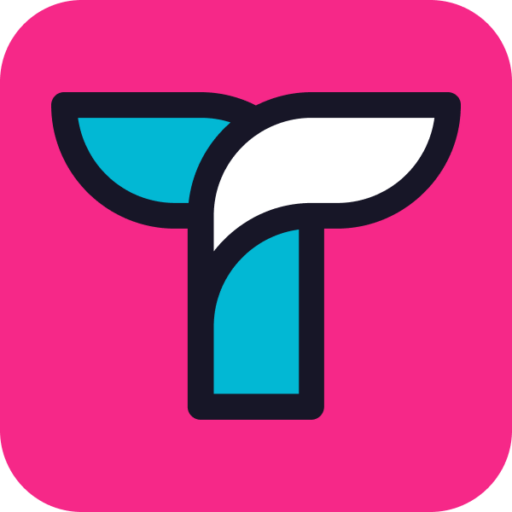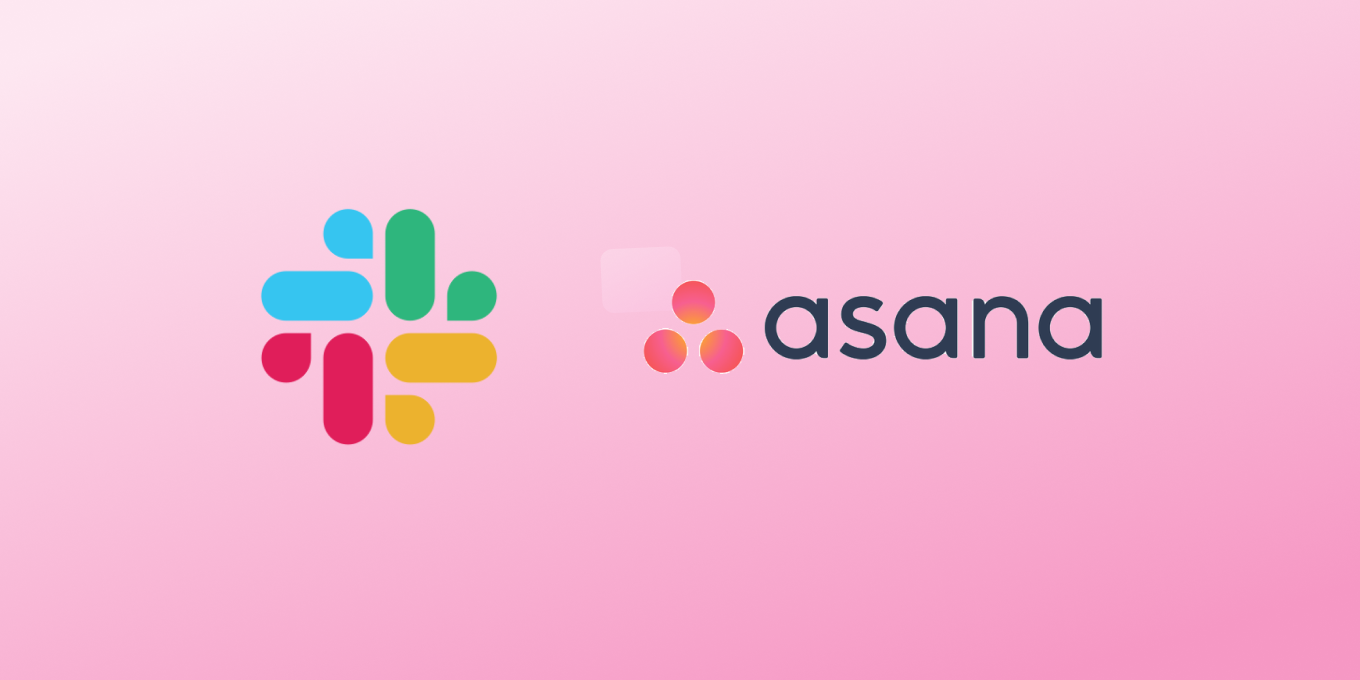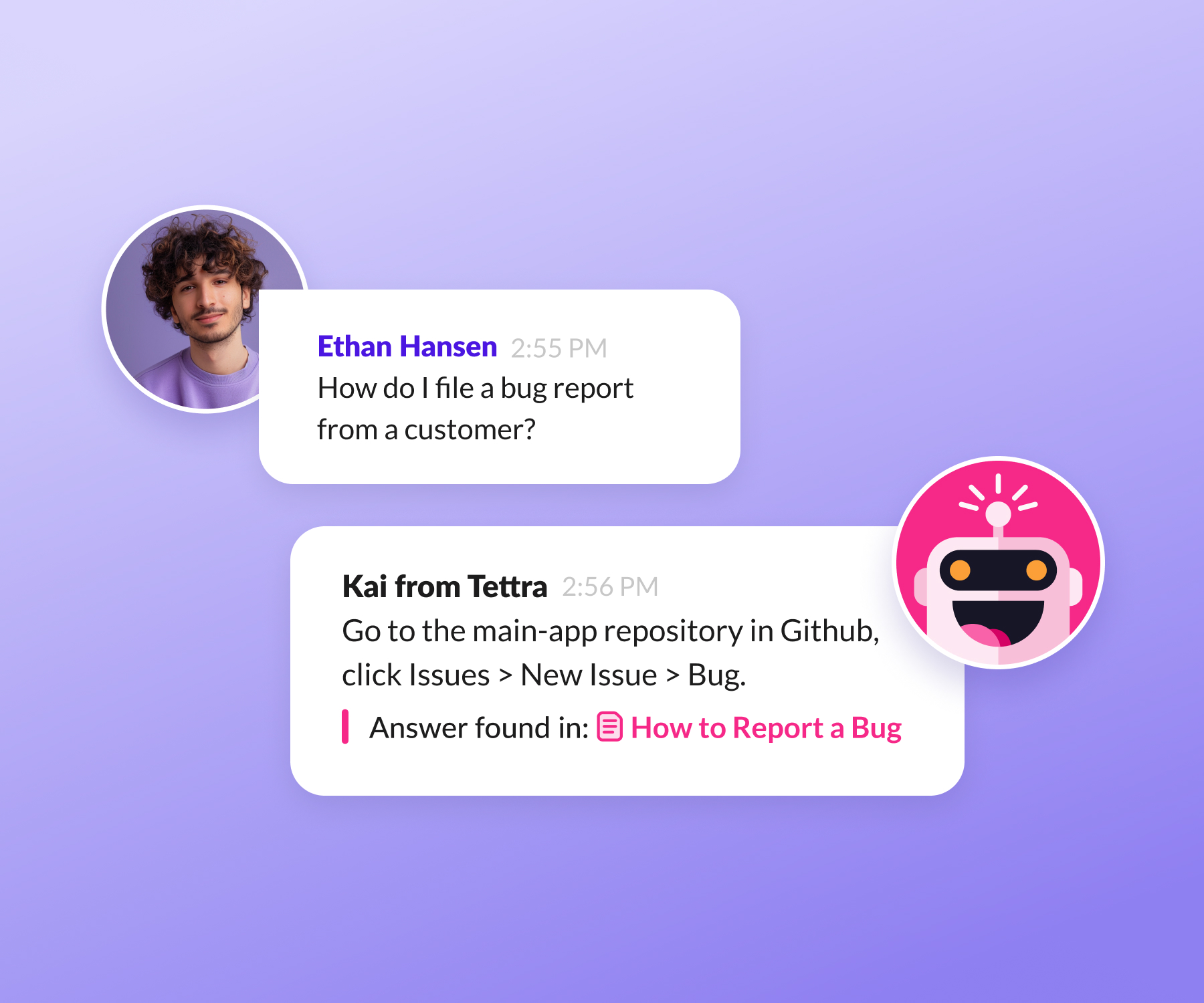TL;DR: Asana is more of a project management tool, and Slack is more of a communication tool. Many teams use Slack and Asana together, along with other workplace tools like Tettra for knowledge management.
What Are Slack and Asana?
With more businesses than ever working remotely, or at least in a hybrid setup, having effective communication and managing projects efficiently is of the utmost importance.
Two popular workplace management tools are Asana and Slack.
When you research team communication, project management, and collaboration tools, these two products will most likely appear in the results.
Slack is quickly growing into one of the most popular communication apps of all time. It’s estimated that the number of active Slack users will be around 79 million by 2025.
Asana is also a popular workplace platform. Asana has over 119,000 paying users and millions of free users worldwide.
However, both products are very different. If you are considering using Slack or Asana, understand what each program provides and does before you decide.
Let’s look at Slack vs. Asana more in-depth so you can decide if either tool is something that your company needs to help things run smoothly.
Slack: What Does It Do?
Slack is a popular workplace communication platform. It allows users to use group chat, direct person-to-person messaging, and video or voice calls. With it, businesses can always stay connected and get the information they need to work productively, especially in remote situations. With Slack, users are able to create channels and workspaces where groups within your business can collaborate and communicate efficiently.
Why Is Slack Popular?
Slack is a popular messaging tool because it allows everyone to get important information in real-time. Instead of sifting through emails or waiting for an answer, you can ask important questions directly on the platform. In addition, it has an intuitive UI that anyone can jump into and learn how to use quickly.
Slack offers a popular and useful free plan for smaller teams. There is a standard option that will cost $6.67 a month. Plus is $12.50 a month. The enterprise option works well for larger groups. You’ll have to contact Slack’s team for enterprise pricing. It is accessible on many platforms, including Windows, Mac, iOS, Android, and web browsers.
There are two main ways to communicate in Slack: channels and direct messaging. The people in your workspace form a directory; any user can communicate with others through the messaging tool.
You can create Slack channels that are smaller groups inside the workspace group. Users on each channel can message team members in the channel. In addition, you could have channels for certain tasks, projects, or anything else that helps streamline your workflow. Whoever creates a channel can give or restrict access to anyone in the workspace.
Slack Top Features
Channels: Slack users can create channels for different teams, projects, or topics, making it easy to keep conversations organized and reduce clutter.
Direct message: Slack has instant messaging to team members, so you can have private conversations without cluttering up a channel.
Voice and video calls: Slack provides voice and video call functionality with Slack Huddles, making it easy to have remote meetings and collaborate with team members in real-time
Integration with other tools: Slack integrates with a variety of other tools, such as Tettra, Google Drive, Trello, and Asana, so you can easily incorporate Slack into your existing workflow.
Customizable notifications: Slack lets you customize your notification settings so you can choose which channels and types of activity you want to be notified about, and how frequently you want to be notified.
Search functionality: Slack provides powerful search functionality, allowing you to quickly find messages, files, and other content within the platform.
File sharing: Slack makes it easy to share files with team members, with the ability to upload and preview files directly within the platform.
App directory: Slack has an extensive directory of apps you can integrate and use. Some major apps you can integrate with Slack include Google Drive, Evernote, Zoom, Asana, Tettra, Trello, and many more. Check out our recommended Slack apps.
Slackbot: Slackbot is a built-in assistant that can help you automate tasks and answer common questions, saving you time and increasing productivity.
Start for free
Furthermore, you can make voice calls on Slack via Slack Huddles, and with the premium plans, you can even make conference calls. Regarding project management or task management, Slack only offers a little. However, Slack can be a great tool if communication and collaboration are key to your business.
Pros:
- Slack lets users stream calls live on social media.
- Slack makes it easy to share data with others.
- Slack integrates well with other tools.
- Slack is simple to get started with and use.
Cons:
- Slack has low audio and video quality.
- Slack doesn’t allow the recording of meetings.
- Slack has minimal storage capacity.
- Slack can become a distraction.
What users are saying about Slack:
“Slack brings all communication into one place, eliminating the need for multiple tools and reducing the time and effort spent switching between them. Slack integrates with a wide range of apps and tools, making sharing and accessing information from different sources in one place easier.”
–G2 review

Get more tips on how to use Slack.
Asana: What Does It Do?
Asana is a cloud-based task management software that offers businesses a place to collaborate, communicate, and manage tasks efficiently.
No matter how big or small a team is, Asana is made to help streamline task management and handle all aspects of the workplace in one space.
In addition, Asana has multiple views for project management: like lists and Kanban-style interfaces that helps make complex projects more visually appealing. Yet, Asana is relatively simple to use and integrate with your business.
Why Is Asana Popular?
One of the reasons that Asana is a popular project management tool is because it keeps everyone in the loop for specific tasks and projects.
One of Asana’s best features is making the workflow much more effortless. For example, team members can access boards, lists, or a calendar that helps everyone manage their work. The workflow builder feature may be the most popular feature because it allows users to use a visual tool to organize, and connect members, automate tasks, integrate third-party apps, and improve processes in one spot.
You can set deadlines, assign tasks, and break down larger projects into smaller, more manageable ones. Asana integrates with other useful third-party apps, including Microsoft Teams, Google Drive, Zoom, Slack, and many other apps your team may use.
Asana Top Features
Task organization: You can organize Asana tasks by project, team, due date, or priority. This helps you keep track of what needs to be done and when.
Collaboration: Asana makes it easy to collaborate with team members by allowing you to assign tasks, share files, and communicate directly within the platform.
Customizable workflows: Asana lets you create custom workflows that match your team’s processes, so you can ensure that tasks are completed in the correct order and with the correct approvals.
Integration with other tools: Asana integrates with a variety of other tools, such as Google Drive, Slack, and Trello, so you can easily incorporate Asana into your existing workflow.
Mobile app: Asana has a mobile app that allows you to access your tasks and projects on the go, making it easy to stay productive even when you’re away from your desk.
Automation: Asana offers automation features that allow you to streamline repetitive tasks, such as sending reminders or moving tasks between projects.
Progress tracking: Asana provides a variety of tools to help you track your team’s progress, including project status updates, progress reports, and team workload views.
Calendar view: Asana has a calendar view that lets you see your tasks and deadlines in a visual format, making it easier to plan your time and stay on schedule.
Reporting: Asana provides detailed reports on team productivity, project status, and other metrics, so you can track your team’s progress and identify areas for improvement.
Asana is available as a desktop application for Windows or Mac, an Android or iOS device app, or a web browser. Pricing ranges from free to more costly advanced and enterprise plans. Asana offers a 30-day free trial for premium and business plans.
Pros:
- Asana has an intelligent UI
- Asana’s free plan is useful for teams on a budget
- Asana offers many useful third-party app integrations, including add-ons
- Asana’s dashboard lets you monitor projects and team members
Cons:
- Asana has limited importing and exporting features.
- Asana only lets you assign a task to one person.
- Asana has no time-tracking reports.
What users are saying about Asana:
“Since implementing Asana, our team’s collaboration, and productivity has increased significantly. The tool has helped us stay organized and aligned in our daily work and long-term projects. It has also increased transparency in the team, as all team members have real-time access to the same projects and tasks.”
–G2 Review
Asana Intelligence is now here
Asana is bringing AI-powered assistance to enhance the efficiency and effectiveness of executives, departments, and entire organizations. This innovative feature offers a smarter approach to clarity and accountability in business operations. It simplifies strategic planning by providing essential organizational insights, helping you set and achieve significant business goals with confidence.
With Smart Goals, Asana Intelligence assists in crafting effective objectives using plain descriptions and analyzing historical performance data. Smart Status, another feature starting today, enables the creation of detailed status updates swiftly, utilizing real-time work data to pinpoint risks, unanswered questions, and obstacles that may impede goal attainment.
Asana Intelligence also introduces Smart Answers. This feature allows users to ask questions in natural language and receive prompt, insightful responses about project statuses, blockers, and recommended next steps. Looking ahead, Asana Intelligence is set to revolutionize how work is conducted organization-wide.
Smart Workflows, a forthcoming feature, will enable the creation of optimized, goal-aligned workflows with just simple instructions. These workflows are designed to evolve over time, adapting to specific organizational goals and established best practices, thereby boosting team handoffs and overall productivity. All these features are powered by the Asana Work Graph®, offering a comprehensive and connected overview of your organization’s work data.
Enhancing Collaboration with Slack Canvas
Slack Canvas brings a new dimension to team collaboration and information sharing within Slack. This innovative feature acts as a unique, integrated workspace where teams can effortlessly curate, access, and share a wealth of knowledge. With Canvas, you can transform the way you capture important project details, enriching your workspace with a diverse array of embedded content, such as files, images, and videos.
The platform encourages active collaboration, allowing team members to co-edit and engage through comments and threads directly within Slack. This seamless integration makes it an essential tool for maintaining clarity and continuity in team communications and project management.
Canvas in Slack offers versatility in usage, catering to both group collaborations and individual tasks. Each Slack conversation, be it a channel or a direct message, is equipped with its own dedicated canvas. This feature serves as a repository for relevant, enduring content related to ongoing discussions and work. Additionally, Canvas can be utilized independently, providing a private space for crafting meeting notes, project outlines, or checklists, which can then be easily shared in the appropriate channel.
Notably, Canvas supports intuitive interactions, such as mentioning team members, custom emoji use, and in-line object additions, further enhancing its utility. With its introduction, Slack transforms its traditional post format into more interactive and engaging canvases, thereby enriching the workspace experience and fostering better team collaboration and information management.
More info about Slack and Asana:
- Compare Confluence vs Asana
- Compare Asana vs Monday for project management
- Slack vs Teams: What’s right for you?
- 15 best Slack apps for productivity
What Are the Key Differences Between Slack and Asana? Do you need both?
Let’s look at the comparative features of Asana vs. Slack. The most noticeable difference between the two is that Asana is more of a project management tool, and Slack is more of a communication tool.
Slack is easier to use than Asana, and it is also ready to go when you open the program, whereas, with Asana, you will need to input data first to get going. On the other hand, Asana has more advanced features than Slack.
Ultimately, it depends on your organization’s unique needs as to which of these tools will be the best choice for your team. Sometimes, it is wise to use the products together.
Slack cannot replace Asana because Slack is a communication tool, not a project management tool.
However, you can easily use Slack with Asana and turn conversations in Slack into tasks on Asana. Regarding sharing files, with Slack, you can add files up to 1GB to share. With Asana, you can share unlimited files as long as they are up to 100MB in size individually.
Many teams use Slack and Asana together, along with other workplace tools like Tettra or another Slack wiki for knowledge management. However, there are other alternatives to each of these.
Some Slack alternative communication tools include the following:
- Microsoft Teams
- Ryver
- Glip
- Jostle
Some Asana alternatives include the following:
- Monday
- Trello
- Wrike
- Jira
- ClickUp
- Notion


